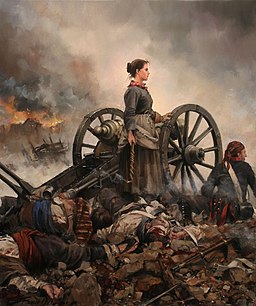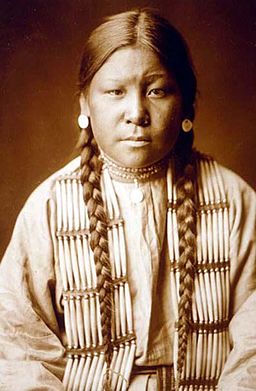As I thought about Women's History Month I knew I wanted to really touch on women in history that may be forgotten. Today women are members of the Armed Forces, but not that long ago they were not allowed. I decided I would focus on women who played important roles in wars. This month I will share about women in the Revolutionary War, Civil War, and the two World Wars. Today I thought I would start with some women who fought wars before America was a country. I have focused on the legend of Mulan in the past. She is one of the women who reportedly disguised herself as a man to fight in a war. Then there was the Greek goddess, Athena, who was the goddess of war, as well as the Amazons, the race of women warriors in Greek mythology. Even the Aztecs had a warrior goddess, Itzpapalotl. Then we know of Joan of Arc and how she led the French army through battles. And we shared about Artemisia in the past. Today let's talk about some of the other women you may not have heard about that fought in real wars and battles. As I started researching women in wars I found The Book of Heroines: Tales of History's Gutsiest Gals by Stephanie Warren Drimmer. All of the women, goddesses and legends mentioned in this post are featured in this book. This book is one of the sources for my entire post. I will list others that I used to find out more about the women and share books for kids when possible. (Note: I have not checked out these books but found them searching my local library website and Amazon.)
Scythians
Trung Sisters
 |
| Statue of the Trung Sisters by Amore Mio at English Wikipedia, CC BY-SA 3.0, via Wikimedia Commons |
Boudicca
 |
| Boudicca Statue by No machine-readable author provided. Lily15 assumed (based on copyright claims)., CC BY-SA 3.0, via Wikimedia Commons |
Zenobia
 |
| Queen Zenobia Addressing Her Soldiers by Giovanni Battista Tiepolo |
Queen Zenobia took over the throne when her husband was assassinated around 267 A.D. Unlike her husband she decided to take the kingdom back from Roman control. In 269 she led a revolt against the Romans. She led her army to seize Egypt and conquered other lands. She controlled important trade routes and issued coins stamped with her image. Around 274 Emperor Aurelian defeated her. She ruled an empire that is present day Syria, Lebanon and Palestine. She ruled over a diverse nation and protected the Christians and Jews even though she was a Pagan. Additional Source: Zenobia - Wikipedia.
Khutulun
 |
| Qutulun Daughter of Qaidu by Maître de la Mazarine, Public domain, via Wikimedia Commons |
Agustina de Aragón
 |
| Agustina de Aragon by Augusto Ferrer-Dalmau, CC BY-SA 3.0, via Wikimedia Commons |
Nakano Takeko
 |
| Nakano Takeko Statue by Torstein Barnhardt, CC BY-SA 4.0, via Wikimedia Commons |
At a young age Nakano Takeko excelled at martial arts. Although she was alive in a time when Japanese women were to keep house and cook, she trained in martial arts and eventually was adopted by her instructor, Akaoka Daisuke. She taught along side him in the 1860s. When a civil war broke out in Japan she wanted to join the Aizu army but was not allowed to because she was female. She formed a female army called Aizu Joshitai. In 1868 the Tokugawa wanted to surrender but the Aizu people refused to give up. Against orders Nakano led her army into battle. It is believed that she killed five soldiers before she was shot and killed. She had asked her sister to cut off her head rather than letting the enemy take it as a trophy. In Japan she is remembered for her bravery and courage. There is a monument for her at the Hokai Temple and at the Aizu Autumn Festival girls wear hakama and shiro headbands and parade around in memory of her and her army. Additional Source: Women Warriors: Nakano Takeko – Yamato Magazine (home.blog)
Buffalo Calf Road Woman
 |
| Buffalo Calf Road Woman |
Buffalo Calf Road Woman was a Cheyenne warrior woman. Her brother was Comes in Sight. She decided to ride with the warriors to the Battle of the Rosebud although many of the men didn't want her to ride with them. General Crook and his army were advancing on their village. At one point she saw her brother trapped by the American soldiers. She rode down to the gully where he was and pulled him onto her horse and brought him to safety even with all the bullets flying around her. The male warriors were impressed since none of them had the guts to try to save him. They named the battle after her and called her Brave Woman. A week later during a battle with General Custer against the Cheyenne, and other tribes, Buffalo Calf Road Woman rode with the male warriors and fought with them. She managed to save the life of a young warrior again. Over months the Cheyenne kept being attacked. Many surrendered but Buffalo Calf Road Woman joined the group of thirty or so who refused. At this point she was pregnant and gave birth to her second child. The conditions became so bad that the group surrendered for the promise of new land. After a long march they arrived on land in Oklahoma which was far different from their land. There was also great disease there. A group of 300 or so Cheyenne including Buffalo Calf Road Woman decided to return to their land. They left at night by foot and walked about 1,500 miles. They were attacked by the army throughout the walk and Buffalo Calf Road Woman continued to fight with the men. Once arriving they split into two groups due to disagreements on how to proceed. One group headed for Red Cloud's Lakota village but they were captured and imprisoned. They escaped from the prison but were massacred. The soldiers killed over 65 Cheyenne men, women and children. The other group was led by Chief Little Wolf and included Buffalo Calf Road Woman and her family. They managed to hide in the Sand Hills of Nebraska, but Buffalo Calf Road Woman's husband killed Black Crane during an argument due to his own madness that was developing. He was banned and his family went with him. Both groups were eventually captured. She was imprisoned at Fort Keogh where she died. Additional Source: Buffalo Calf Road, Heroic Cheyenne Warrior Woman | Amazing Women In History
That is the first of our exploration of women in wars. Next week we will focus on women in the Revolutionary War (USA). I hope you will join us!







